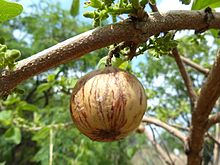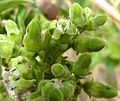Vanguerieae
| Vanguerieae | |
|---|---|

| |
| Canthium coromandelicum | |
| Scientific classification | |
| Kingdom: | Plantae |
| Clade: | Tracheophytes |
| Clade: | Angiosperms |
| Clade: | Eudicots |
| Clade: | Asterids |
| Order: | Gentianales |
| Family: | Rubiaceae |
| Subfamily: | Ixoroideae |
| Tribe: | Vanguerieae A.Rich. ex Dumort. |
| Type genus | |
| Vangueria | |
Vanguerieae is a
Description


Several different life forms are present in the tribe: most species are shrubs, but geofructices (plants with woody rhizomes) (e.g. Fadogia homblei, Pygmaeothamnus zeyheri), small trees (e.g. Vangueria infausta), and climbers (e.g. Keetia gueinzii) also occur. As all Rubiaceae species, the leaves are opposite, simple and entire, and they have interpetiolar stipules. The phyllotaxis is decussate, sometimes conspicuously so (e.g. Canthium inerme), and rarely whorled (e.g. Fadogia). Some species have spines (e.g. Canthium). Secondary pollen presentation is characteristic for the tribe and the species develop a conspicuous “stylar head”-complex, which is a structural unit consisting of a pollen presenting organ combined with stigmatic surfaces.[2]
Distribution and habitat
The species of this tribe are found in the
The tribe is characterized by a high degree of endemism. Several monotypic genera have a restricted distribution range: Eriosemopsis is found in the KwaZulu-Natal province of South Africa, Everistia occurs in the Eastern states of Australia, Perakanthus occurs in Peninsular Malaysia, and Temnocalyx is only found in southwestern Tanzania. Other larger genera with a restricted range are Cyclophyllum that is mainly found in New Caledonia, Peponidium that is only found on Madagascar or the Comoros, and Pyrostria of which most species are restricted to Madagascar.
The tribe is a common and important constituent of many different kinds of
Ecology
There is a wide range of flower sizes and fruit morphologies, suggesting different adaptations to pollination and dispersal. Most of the species are probably pollinated by insects, but it is suspected that at least some of the large-flowered species of Fadogia are bird-pollinated. The edibility of many fruits suggests that they are dispersed by animals.
Almost 30% of the species within the tribe have a symbiosis with endophytic bacteria, which are found intercellularly within the leaves.[3][4][5] The presence of these bacteria is consistent on a genus level and all species belong to the following 5 genera: Fadogia, Fadogiella, Globulostylis, Rytigynia, and Vangueria. The bacteria are identified as Burkholderia, which is a genus that is also found in the leaves of other Rubiaceae species.[6] The hypothesis is that these endophytic bacteria provide chemical protection against insect herbivory.[7]
Uses

Some species are consumed locally and fruits may be used as famine food. Examples are African medlar (Vangueria infausta) and Spanish tamarind (Vangueria madagascariensis), but the fruits of other Vangueria and Fadogia species are edible too.
In West Africa, Vangueria agrestis (known under its old name Fadogia agrestis) is traditionally used as an aphrodisiac. It is known as bakin gagai (Hausa) or black aphrodisiac.[8]
Systematics
Taxonomy
The first genus of the tribe to be described was Canthium, containing the species C. coronatum (now Catunaregam spinosa in the Gardenieae tribe) and C. parviflorum (now C. coromandelicum).[9] The second genus to be described was Psydrax, containing the species Psydrax dicoccos.[10] Although the tribe is predominantly found in Africa, these first described species are Asiatic taxa. The first non-Asiatic taxa to be described were the genera Pyrostria and Vangueria, based on material collected on Western Indian Ocean islands.[11] The first genus from continental Africa was Cuviera, with the species Cuviera acutiflora from Sierra Leone.[12] Dumortier first mentioned a tribe Vanguerieae (as “Vaugnerieae”) attributed to Achille Richard and put the genera Hamelia, Evosmia, Mitchella, “Vaugneria” (Vangueria), and Nonatelia in it.[13] However, this circumscription of the tribe was far from correct, as Canthium and Cuviera were put in different tribes and Psydrax and Pyrostria were not even mentioned. Also, the only genus that actually belongs in the tribe is Vangueria; the other genera belong elsewhere. At that time, authors often used the number of locules as a character for delimiting groups, but this is problematic for Vanguerieae as both 2-locular (e.g. Canthium) and 5-locular (e.g. Vangueria) ovaries occur in the tribe. The first monograph of the tribe was performed by Walter Robyns in 1928 and a total of 17 genera were allocated to the tribe.[14] Although 9 new genera were described, this work was not entirely complete, e.g. Canthium, Cuviera, and Pyrostria were not treated. Since then, several new genera have been described or made synonym and more taxonomic adjustments on genus level will probably still be necessary.
Genera
Currently accepted names[1]
- Afrocanthium (Bridson) Lantz & B.Bremer (17 sp)
- Bridsonia Verstraete & A.E.van Wyk (1 sp)
- Bullockia (Bridson) Razafim., Lantz & B.Bremer (6 sp)
- Canthium Lam. (81 sp)
- Canthiumera K.M.Wong & Mahyuni (4 sp)
- Cuviera DC. (10+6 sp)
- Cyclophyllum Hook.f. (44 sp)
- Dibridsonia K.M.Wong (3 sp)
- Eriosemopsis Robyns (1 sp)
- Everistia S.T.Reynolds & R.J.F.Hend. (1 sp)
- Fadogia Schweinf. (40 sp)
- Fadogiella Robyns (3 sp)
- Globulostylis Wernham (8 sp)
- Hutchinsonia Robyns (2 sp)
- Kanapia Arriola & Alejandro (2 sp)
- Keetia E.Philipps (36 sp)
- Meyna Roxb. ex Link (9 sp)
- Multidentia Gilli (10 sp)
- Peponidium (Baill.) Arènes (48 sp)
- Perakanthus Robyns ex Ridl. (1 sp)
- Plectroniella Robyns(1 sp)
- Psydrax Gaertn. (90 sp)
- Pygmaeothamnus Robyns (1 sp)
- Pyrostria Comm. ex A.Juss. (67 sp)
- Robynsia Hutch. (1 sp)
- Rytigynia Blume (82 sp)
- Temnocalyx Robyns (1 sp)
- Vangueria Juss. (58 sp)
- Vangueriella Verdc. (18 sp)
- Vangueriopsis Robyns (4 sp)
Synonyms
- Ancylanthos Desf. = Vangueria
- Clusiophyllea Baill. = Canthium
- Dinocanthium Bremek. = Pyrostria
- Dondisia DC. = Canthium
- Lagynias E.Mey. ex Robyns = Vangueria
- Leroya Cavaco = Pyrostria
- Lycioserissa
- Mesoptera Hook.f. = Psydrax
- Neoleroya Cavaco = Pyrostria
- Pachystigma Hochst. = Vangueria
- Phallaria Schumach. & Thonn. = Psydrax
- Plectronia Lour. = Canthium, Peponidium, Psydrax
- Pseudopeponidium Homolle ex Arènes = Pyrostria
- Psilostoma Klotzsch ex Eckl. & Zeyh. = Canthium
- Rhopalobrachium Schltr. & K.Krause = Cyclophyllum
- Scyphochlamys Balf.f. = Pyrostria
- Tapiphyllum Robyns = Vangueria
- Rohr = Vangueria
Phylogenetic relationships
The following
| Vanguerieae |
| ||||||||||||||||||||||||||||||||||||||||||||||||||||||||||||||||||||||||||||||||||||||||||||||||||||||||||||
Image gallery
-
Everistia vacciniifolia
-
Plectroniella armata
References
- ^ a b c POWO (2019). "Plants of the World Online". Royal Botanic Gardens, Kew. Archived from the original on March 22, 2017. Retrieved March 26, 2021.
- S2CID 33654368.
- ^ PMID 23372845.
- ^ .
- ^ PMID 24275705.
- PMID 21915326.
- PMID 26033226.
- S2CID 34724459.
- ^ Lamarck JBAPM de (1783). Encyclopédie Méthodique, Botanique. Vol. 1. Paris & Liège: Panckoucke & Plomteux. p. 602.
- ^ Gaertner J (1788). De Fructibus et Seminibus Plantarum. Vol. 1. Stuttgart: Typis Academiae Carolinae. p. 125.
- ^ Jussieu AL de (1789). Genera Plantarum. Paris: Herissant & Barrois. p. 206.
- ^ de Candolle AP (1807). "Mémoire sur le Cuviera". Annales du Muséum National d'Histoire Naturelle. 9: 216–222.
- ^ Dumortier BCJ (1829). Analyse des Familles des Plantes. Tournay: J Casterman. p. 32.
- JSTOR 3666476.
- S2CID 14815565.)
{{cite journal}}: CS1 maint: multiple names: authors list (link - .
- S2CID 30867982.
- S2CID 86065468.















